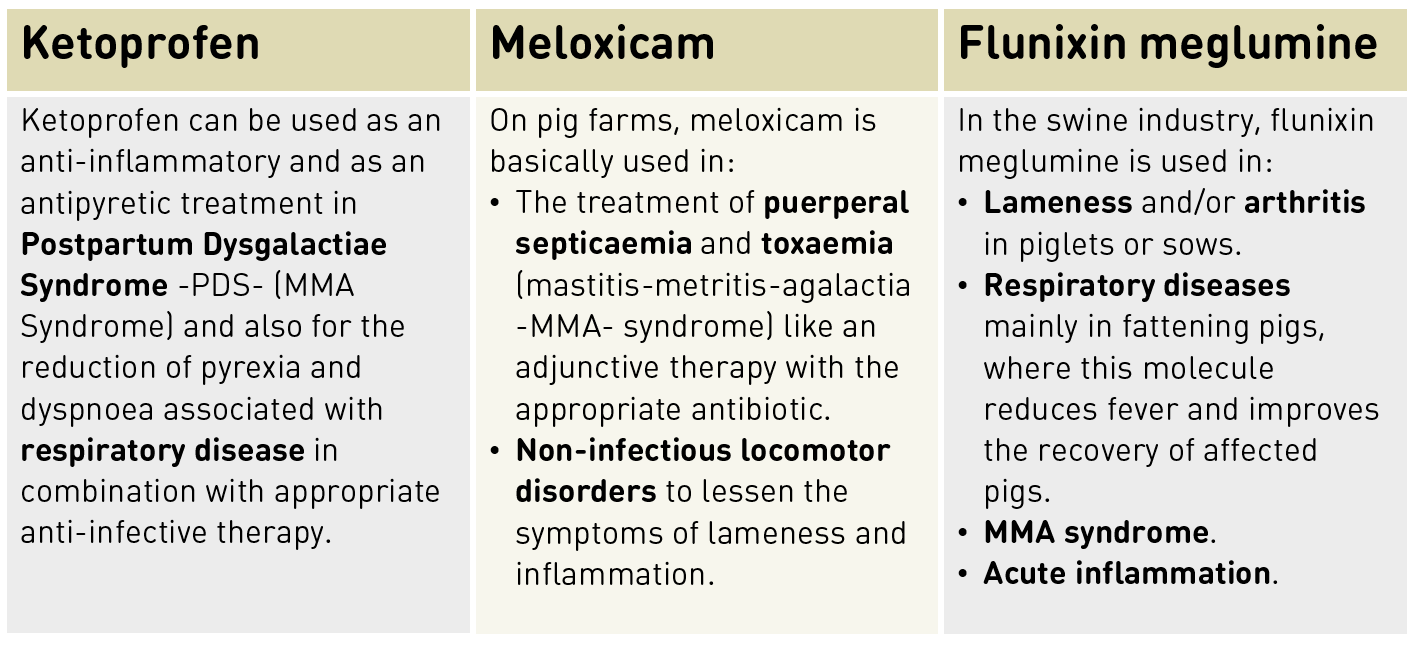Importance of anti-inflammatory drugs in pigs
Anti-inflammatories are one of the most administered drugs in livestock species and they can be used as adjuvants in the treatment of infectious diseases (e.g., sepsis), as antipyretics or to deal with localized inflammatory processes (such as arthritis).
Effects on animal welfare due to inflammation and pain
Trends and opinions about animal welfare have changed over the years increasing the focus on the pain management in livestock.
Nowadays it is thought that even minor surgical procedures should be performed using combinations of different types of anesthesia, such us regional, local and general, and also with uninterrupted post-surgical analgesia.
Tail docking, castration and/or ear tattooing/tagging are procedures that require pain control, but this is not always implemented. For instance, although castration is known to be a painful procedure, based on specific behavioral and physiologic indicators, yet piglets do not generally receive any anesthesia for pain relief. Furthermore, there are situations such as prolapses, fractures or bites where animals suffer and pain could be reduced or eliminated.
Besides any ethical consideration, economical losses associated to reduction in appetite and growth retardation are also a problem. For example, Swine Respiratory Disease (SRD in growing and finishing pigs limits herd profitability, due to:
- Morbidity ranging from 10 % to 40 %.
- Mortality varying from 2 % to 20 %.
- Poor growth performance.
Ways to manage and reduce pain in swine farms
Types of anti-nociceptive drugs that can be administered to swine include:
• Non-steroidal anti-inflammatory drugs (NSAID): they are broadly used in animal production practice to relieve the adverse effects associated with the inflammatory cascade such as excessive swelling, fever or pain. The aim of using NSAIDs is to improve the welfare of the animals and recover their performance, that is often impaired by chronic pain, inflammation and fever. NSAIDs inhibit cyclooxygenase in a reversible and non-selective way and they have less secondary effects than SAIDs.
• Local analgesics. This class of drugs, such as lidocaine, are useful in reducing nociception signs during castration.
• Steroidal anti-inflammatory drugs (SAID): they are indicated for the treatment of muscular and joint inflammatory processes, meningitis, etc. Dexamethasone is one of the drugs most used in pigs within this category.
NSAIDs: effects, categories and management in swine farms
The principal mechanism of action of NSAIDs is the inhibition of cyclooxygenase (COX), which inhibits the synthesis of prostaglandins (PG). Pro-inflammatory PGs have two important roles in the inflammation process:
1. Hyperalgesia (abnormally increased sensitivity to pain). 2. Dilate the arterioles, increasing blood flow to the area of injury
There are many COX inhibitors, and among the non-selective ones two main groups of NSAIDs are present:
- Carboxylic acids: including nicotinic acid (flunixin meglumine) and propionates (ketoprofen).
- Enolic acids: including oxicams (meloxicam).
Many studies show that NSAIDs administered to:
- Growing and finishing pigs: are useful in case of lameness and/or respiratory problems (administered together with antibiotic treatment, if necessary).
- Sows: to help them in recovering from a painful situation such as lameness or post-partum dysgalactia syndrome. NSAIDs also decrease the mortality rate at weaning in litters from healthy sows and in sows with dysgalactia syndrome.
- Piglets: NSAIDs such as meloxicam and ketoprofen are the most used types of analgesic given to food animals and are now being recommended for use in piglets to reduce pain.

References
-George L.V., Pain Control in Food Animals, In: Recent Advances in Anesthetic Management of Large Domestic Animals, Editor(s): Steffey E.P., Publisher: International Veterinary Information Service (IVIS), 2005..
-Martelli P, Segalés i Coma J, Torremorell M, et al. Swine respiratory disease. ISBN: 9788417225865, 2019.
-Mette S. Herskin, Pierpaolo Di Giminiani, 11 - Pain in pigs: Characterisation, mechanisms and indicators, Editor(s): Marek Špinka, In Woodhead Publishing Series in Food Science, Technology and Nutrition, Advances in Pig Welfare, Woodhead Publishing, 2018
-Navarro E, Mainau E, de Miguel R, Temple D, Salas M and Manteca X (2021) Oral Meloxicam Administration in Sows at Farrowing and Its Effects on Piglet Immunity Transfer and Growth. Front. Vet. Sci. 8:574250. doi: 10.3389/fvets.2021.574250.
-Saller AM, Werner J, Reiser J, Senf S, Deffner P, Abendscho ̈ n N, et al. (2020) Local anesthesia in piglets undergoing castration—A comparative study to investigate the analgesic effects of four local anesthetics on the basis of acute physiological responses and limb movements. PLoS ONE 15(7): e0236742. https:// doi.org/10.1371/journal.pone.0236742
-Viscardi AV and Turner PV (2018) Use of Meloxicam or Ketoprofen for Piglet Pain Control Following Surgical Castration. Front. Vet. Sci. 5:299. doi: 10.3389/fvets.2018.00299.
-Zimmerman JJ, Karriker, LA, Ramirez A, et al. Disease of Swine, 10th edition. ISBN 978-0-8138-2267-9 , 201l
